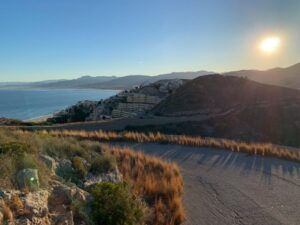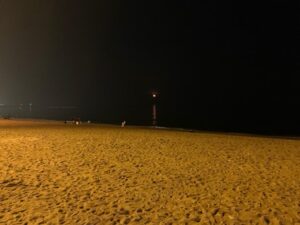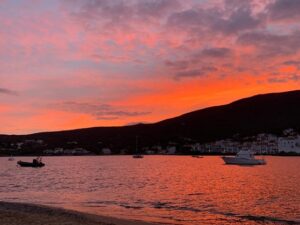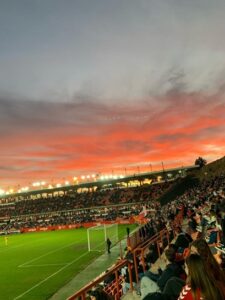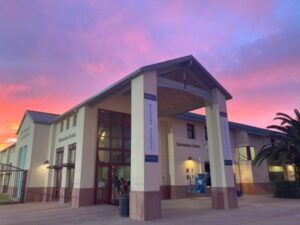Kategorie: ‘Chemistry’
Writing my Master Thesis in Trondheim
- Chemistry M. Sc.
- Norway, Trondheim
- Norges Teknisk-Naturvitenskapelige Universitet
- 07/2024 – 01/2025

Figure 1: Cross-country skiing on Finsevatnet in Finse, mid-January. ©Julia Wang
Preparations
People often ask for the reason I chose Norway: Initially, I planned to do an internship in Sweden and then return to Germany for my thesis. Unfortunately, I lost contact to my Swedish prof, and as time was running out, I finished all required internships in Germany. However, I struggled to find a suitable thesis topic, so I decided to write it externally, including universities from countries in Ireland and Scandinavia in my search. I wanted to improve my English skills and also experience a place full of nature I have never been to before. As the nature in Ireland, Sweden, Norway, and Finland is beautiful, I ultimately found that Norway was the best fit for me. It offered a fascinating language but still with the comfort to speak English anytime, stunning landscapes, beautiful nature, a vibrant student city, and an exciting thesis topic.
I came across the topic of my thesis by proactively reaching out to professors working in areas I found particularly intriguing. As a chemistry student, I was often dissatisfied with the specializations at my university, so learning that Norway has a strong focus on environmental chemistry caught my attention. After a response from a professor, we had a brief meeting where he introduced me to a project based within the Arctic Circle, combining environmental chemistry with fundamental research. The process of signing the OLA was incredibly slow, but once that was finalized, there was nothing standing between me and my successful thesis – well, except for one thing: accommodation.
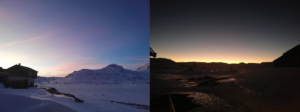
Figure 2: Stunning sunset in Finse, mid-January. ©Julia Wang
Accommodation & Living expenses
Overall, Norway is more expensive in nearly everything, which makes sense given their higher income. Usually, it is possible for exchange students to apply for student dorms (e.g. at Moholt). Those are particularly nice because of the large student communities that make it easy to meet new people. However, since I arrived in the winter semester – when most new local and exchange students come – the dorms were fully booked. As an internship student from Europe, I wasn’t automatically eligible for housing, so I had to request dorm accommodation. Even then, priority is typically given to international students from outside Europe and those attending summer courses at NTNU.
Thus, I ended up looking through the private housing market. Luckily, I found a room in a Norwegian student’s flatshare that was subletting for the exact duration of my stay. The flatshare with 4 people was comparably affordable and with 5300 NOK (everything included) even cheaper than the dorms. My place was located near Solsiden, which wasn’t exactly close to the university, but the area was well-connected by buses. It was also closer to the city center, as Tyholt and Moholt were about a 25-minute bus ride away. Personally, I preferred cycling since it is faster, cheaper, and the terrain was less steep compared to Gløshaugen-Moholt, which was a nice bonus.
As for the general living expenses, being a vegetarian made it a bit challenging to find affordable fresh vegetables, as everything tends to be more expensive and often heavily packaged in plastic. However, you get used to the prices after a while. As someone who loves tofu, I found it difficult to find good, firm Asian-style tofu. Common supermarket chains include Rema1000, Bunnpris, and Coop Mega for cheaper options, while Kiwi and Meny are more expensive. There are also online discounts and QR codes that offer discounts on specific products, and it’s helpful to ask around in ESN groups, as they often share these codes. I also found myself visiting Asian markets, like NM Market for the best deals on rice, soy sauce, and paneer at Melon Midtbyen. In general, products with higher fat, sugar, or imported goods were about twice as expensive as in Germany. However, Norwegians tend to offer larger packaging, which can help reduce the price per unit.
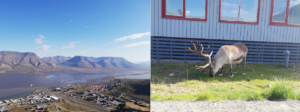
Figure 3: Parts of Longyearbyen and the Adventfjorden from the Varden viewpoint (left) and Svalbard reindeer in the middle of town (right). ©Julia Wang
Everyday life/the internship
Since I was doing my master thesis, my workload was higher compared to an average exchange student. I did miss out a bit on some activities since I was less flexible and had less free time. However, Norwegian work culture is much more chill and laid back than back in Germany. Nobody will ask you to come early and nobody cares if you leave early. Therefore, you need even more discipline to stay on track. Typical work hours in Norway are from 8am to 4pm. Afterwards, people head home for dinner. Many shops also close around 4 or 5 pm, so it’s a good idea to check their hours in advance to plan accordingly.
My thesis involved a field trip to Svalbard in mid-August, where I collected samples, spent time in the lab back In Trondheim, and then focused on writing the thesis. The working groups at NTNU are pretty small, so it is easy to get an overview but I rarely met everyone at once. Knowing how close people work together in working groups in Germany, sometimes I felt a bit lonely and disconnected from PhD or master students. However, I also enjoyed the independence I had to plan my own research, discuss it with my professor (who, by the way, dedicated a lot more time to me than the average professor in Germany would for a master’s student), and work closely with my supervisor. I also enjoyed the flexibility in how I structured my daily work and writing process.
In the evenings, I usually took part in various free-time activities including choir, anime screenings, board games, swimming, 3D printing, sewing, knitting, or baking. On weekends, I usually met up with friends, did my chores, or went on hikes and trips around the area. Sometimes, and further. With a bit of planning, you can easily bring your work with you, as many trains offer Wi-Fi! That way, you can explore places like Åndalsnes, Bergen, Finse (!!!), and more.
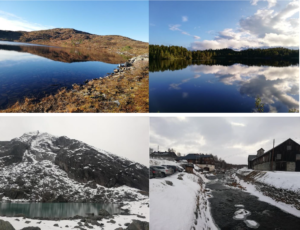
Figure 4: Stunning lakes and rivers found during hikes across Norway. Grytvatnet is found close to Vinjeøra, (upper left), Stordamvatnet is close to Lundamo (upper right), Hurrungsvatnet is near Åndalsnes (bottom left), and the Glomma river runs through Rørøs (bottom right). ©Julia Wang
Free time/tips
Trondheim is a big student city, so you will find all kinds of people. While connecting with international students was quite easy, since everyone is desperate to find friends, I was more interested stepping outside the Erasmus bubble and meeting Norwegians. And the stereotype holds true: While Norwegians are friendly and somehow open to start a conversation, there can still be a sense of distance. Personally, I’ve never been the most social or chatty person, so I always struggled to form deeper connections with anyone. That said, living with Norwegians and joining Norwegian clubs really helped me engage more with locals.
Norway is known for its stunning and beautiful nature (northern lights, midnight sun, mountains, fjords, lush green forests wherever you go!) and almost all Norwegians are big sports enthusiasts. NTNU has a student organization called NTNUI, where you can sign up for various sports clubs. Its very close to what American sports teams are like. People are competitive and passionate about their activities. If you want to try something typical Norwegian: You can join a group that teaches halling, a traditional Norwegian dance, or even take up sword fighting through another separate group.
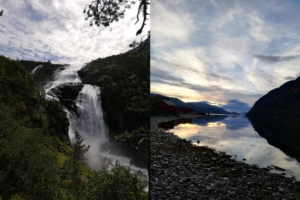
Figure 5: Because scenary with water is so beautiful: The stunning Nyastølfossen is found close to Kinsarvik on a 3-4 waterfall hike (left) and the beautiful sunset over Vinjefjorden can be observed in Vinjeøra (right). ©Julia Wang
If you are not into sports, there are still many student groups you can join: As for me, I joined a group called PVV for board games and anime. In general, they have a different focus but they also offer great social activities. I also joined a choir (NTNU motettkor), conducted by one of Norway’s most famous conductors and a group of Norwegian music students. The group was a fun mix of exchange students and locals, and the conductor was incredibly motivating, making it a truly enjoyable experience. Another popular hobby in Norway is knitting, with knitting events often hosted at cafés or yarn shops. It’s a relaxing activity, especially on those cold, rainy days. I also had the chance to learn 3D printing and practice sewing at the MakeNTNU workshop, where you can book time on a machine to create whatever you like (They are getting new printers, finally!!).
Another great place that offers cool events is the student building down the road from the technical university building: Studentersamfundet. It is definitely worth a visit, as they offer concerts, talk shows, discussions, I addition to having restaurants and more.
As for Trondheim, nature is incredibly accessible. You can enjoy small walks along the coast to the fjord in Lademoen, hikes in Estenstadmarka to the southeast, or head to Bymarka to the west. In winter, Bymarka is perfect for cross-country skiing. For bigger adventures, the ESN group organizes trips to Lofoten, Lapland, and other places. Otherwise, it is advisable to form small groups and rent a car to get around, especially in winter. While many people opt for Airbnbs, I highly recommend trying the great network of cabins in Norway! NTNUI Koiene have basic cabins around Trøndelag but personally, I suggest going for the DNT cabins as they are more spacious and comfortable.

Figure 6: The common room in the DNT Brebua cabin in Finse (upper left), the DNT Venjedalsbu cabin close to Åndalsnes (upper right), a private cabin at Bymarka close to Ringvål (bottom left), and the Flåkoia NTNUI cabin near Lundamo (bottom right). ©Julia Wang
Conclusion
If you are an outdoor enthusiast who enjoys nature and want to experience a new culture during your internship or your thesis with excellent supervision and a nice work environment, I definitely recommend Norway. Not only did I gain insight into the country and its people, but I also embraced a new way of living my life while staying productive. There are plenty of opportunities and activities that allow you to connect with others. You just have to step out of your comfort zone and start engaging people!
I hope you enjoy your time here as much as I did if you choose Norway.
P.S. Yes, it does get pretty dark and depressing from November to February (Average daylight around 5h in Trondheim). But trust me, the experience alone is worth it. Plus, the midnight sun and longer days in summer make up for it!
Research Internship in Valencia
- Chemistry M.Sc.
- Spain, Valencia
- Universitat de València
- 01/2024 – 04/2024
Application and finding an internship:
After careful consideration, I was convinced that Valencia was the right city for me. I had heard many good things about Valencia: the city seemed to offer what I was looking for, and, as I expected, people spoke “normal” Spanish.
Subsequently, I wrote emails with my resume and academic transcripts to professors and group leaders at universities and some independent institutes. My recommendation would be to reach out to as many as possible. Out of 25 recipients, approximately 15 responded; 10 were unavailable, lacked capacity, or only took interns for longer periods. Among the 5 positive responses, I scheduled short meetings with 2 individuals to make the most informed decision possible. In the end, I decided to do an internship in inorganic chemistry at the University of Valencia. The professor spoke good English, the laboratories were spacious and modern, and I had the feeling that they were happy to have an additional motivated employee.
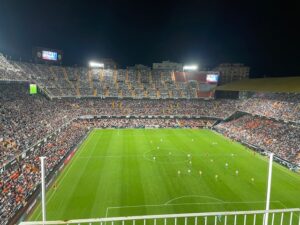
© Jona Sieberg
Accommodation & Living Expenses:
I found searching for accommodation from Germany, without knowing Spanish, to be quite challenging. While many recommended Idealista as the best possible website, where you can find a lot, I ultimately found my apartment through Uni-Places. Although there was a fee involved, it also provided a certain level of security against scams. I live incredibly centrally, not really close to the university, but with the free public transport (for people under 30), I can reach my workplace in 35 minutes. However, I have found Valencia to be very well connected, so the exact location of your flat is not so important.
When I first started looking for an apartment I would have liked to live alone, but decided to go for the cheaper option of a shared flat. In retrospect I would now strongly advise everyone to do the same. Social interaction and contacts are one of the core elements of an Erasmus stay, which should not be missed at any point. Based on my experience with shared accommodation and hearing about others’ experiences, there will always be pros and cons, but I have not heard from any situations that were unbearable.
Sidenote: During the summer months, a room without air conditioning is maybe somewhat bearable but not very desirable.
Monthly expenses for groceries in the supermarket are certainly somewhat lower than in Germany, although not by much. The only thing that is a little more expensive than what we are used to is Ice-cream. Everything else depends on your lifestyle.

© Jona Sieberg
Prices for shared rooms range from approximately 300 to 550 euros. Clubs are often free through Erasmus organizers, and restaurants and gyms are also slightly cheaper than in Germany.
Everyday Life / The Internship:
My internship itself didn’t really differ from similar tasks in Germany: I worked in the laboratory, sometimes under supervision, mostly independently. Only the feeling of arriving in a group of Spanish people, making friends, and then also doing things together outside of university felt even cooler. I dealt with great people, a relaxed yet dedicated professor, a doctoral student with whom I couldn’t have gotten along better, and a generally very friendly group. The willingness to help each other was high, working hours were very flexible, and hierarchies were flat.
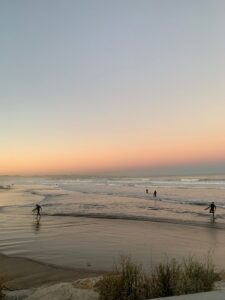
© Jona Sieberg
In this regard, my impressions were minimally different from Germany. I was usually in the lab between just before 10 am and 6 pm, but as everything was relatively relaxed, a lot of it was voluntary. Overall, there was certainly time for sports, activities on the weekends, and enjoying the feeling of living in Spain! I found it to be a great opportunity to expand my knowledge, learned a lot, and certainly gained more confidence in my abilities through the experiences I had.
The biggest difference in everyday life: You don’t have to look out the window to know what the weather is like. Valencia lives up to its promises and offers, although it may not be the most beautiful city in the world, good weather, nearly every day.
My hope was to make great progress in Spanish as well as gaining professional experience. This is perhaps possible if you already speak relatively good Spanish, but as long as English is still much easier for both sides, I had little success. The university, as the place where I spent most of my time, is simply unsuitable for this, as people here speak generally better English than elsewhere.
Free Time / Tips:
Beach, great weather, culture, local markets, the feeling of a big but not too big city, clubs, parks, huge university campuses, and all of it easily accessible. As mentioned, there is certainly no shortage of options. Erasmus organizations offer a particularly easy entry, offering a variety of activities. For example, I participated in their surfing and beach volleyball offerings, parties, and excursions. The excursions, in particular, are very pleasant because you can reach nearby cities or locations relatively inexpensively. Especially the mountains, which are otherwise difficult to reach without a car.
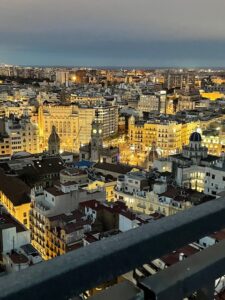
© Jona Sieberg
Valencia certainly does not lack bars where you can sit down nicely in the evening. Additionally, there are also many opportunities to sit outside with your friends. If I were to make a recommendation, I would suggest the very authentic Mercabañal, located very close to the beach.
As an absolute Erasmus hotspot, one should not expect to only deal with spanish people. On the contrary: It is very international, and this is reflected wherever students are. While I mainly dealt with Spaniards in the lab, my roommates and the visitors to clubs and bars were often from abroad.
I used my free time a lot to do sports, often in the gym, partly because it was often much cooler there. Running is a bit less pleasant in Valencia than in Aachen, but with the Turia (the largest park that leads in a semicircle through the city), there is an extremely bicycle and jogger-friendly park. Various football fields are also located here, where people often meet up through WhatsApp groups.
Conclusion:
I can highly recommend Valencia as a destination for an Erasmus stay. At the end of my time here, I feel like I have participated in the hustle and bustle of a Spanish university and made progress in my field, as well as had a great time in Spain. The only thing Valencia doesn’t offer is the feeling of being in a super fancy metropolis with incredibly modern skyscrapers. For everything else you hope for from your stay abroad, Valencia offers the ideal conditions. You just have to do it! Have fun!
Research Internship at DuPont de Nemours in Luxembourg
- Chemistry M.Sc.
- Luxembourg, Contern
- DuPont de Nemours Luxembourg
- 10/2023 – 02/2024
Application/Finding an internship
The Chemistry M.Sc. program at RWTH Aachen University requires three research internships, which can be completed externally, providing students with the opportunity of valuable work and life experience. While students can do an external internship in a specific research group, it is also possible to apply for an external industrial research internship. That is why I thought an internship at DuPont de Nemours in Luxembourg would provide me with valuable insights into the chemical industry, which is a potential career path for me as a chemist. DuPont de Nemours is one of the biggest chemical groups in Luxembourg and worldwide.
I took the initiative to organize my stay in Luxembourg and apply for this internship independently, without any recommendation from a professor or advertisement from the University. In October 2022, I reached out to one of the leading scientists at the company via email and after several months of communication, I was invited to an interview. Finally, in August 2023, I received the confirmation that I had secured the internship. This allowed me to have enough time to plan everything in advance before the start date. Based on my experience, I highly recommend planning an external industrial internship 9-12 months in advance.
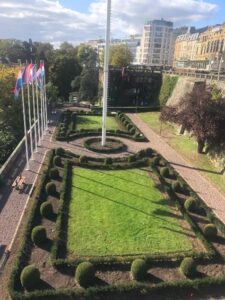
© Leon Maßem
Accommodation & Living expenses
My job was in Contern, a commune in the south of Luxembourg, east of the capital, Luxembourg City (usually referred to as the ‘city’). Finding an apartment close to the city for a reasonable price is almost impossible, as the price per square meter is close to 50€, making it impossible to finance with the Erasmus grant. I was happy to find and live in a small flat in the border area in the north-east of Luxembourg. The rent is lower and the opportunity to go shopping in Germany is very valuable. It is a fact that the cost of living in Luxembourg is 1.5 or even 2 times higher than in Germany for many products. Therefore, it is not surprising that many Luxembourgers prefer to go shopping in France or Germany. However, it is important to note that petrol, coffee, bread or tobacco are exceptions and this leads to fuel tourism in the border regions of Luxembourg. Wasserbillig is a city located on the border with Germany. It has 11 petrol stations, which I found quite amusing. Overall, I was not able to compensate all the cost with the Erasmus Grant and I had to use some of the salary that I got from work. Since the living expenses are that high, everyone should keep that in mind when planning on going to Luxembourg.
Getting around in Luxembourg is incredibly easy thanks to the country’s excellent public transport network, which is completely free.
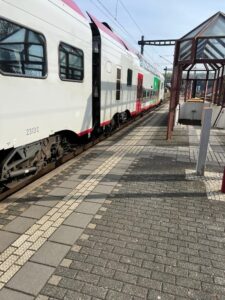
© Leon Maßem
Luxembourg is a relatively small country and the government invests heavily in its public transport system, making it possible to cross the entire country in just one hour or reach the city from the far east in just 30 minutes. This commitment was implemented to reduce car traffic which is a big problem when going towards the city. It’s no wonder that many cross-border commuters choose to rely on public transport when driving to work in Luxembourg. That is why I always chose to take the free train to work and I can recommend everyone to do so as well.
Everyday life/the internship
My contract was for a 40-hour week with 11 days of holiday over 20 weeks. I was pleased with the number of vacation days, especially since former interns at the company had reported receiving none.
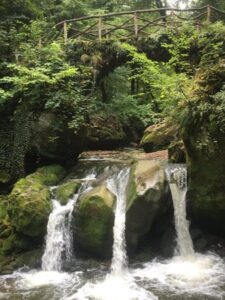
© Leon Maßem
I woke up at 6:00 am each day and left my home at 6:30 am by car. I took the option of travelling to Wasserbillig, which only took 10 minutes, and from there, I could take either the fast RE train (20 minutes to Contern) or the RB train (34 minutes to Contern). Trains arrive alternately every 15 minutes, resulting in a frequency of 4 trains per hour. I got on the train at 6.54am and arrived at Contern station at 7.18am. CFL’s service is highly reliable, better than DB’s and the train was almost always on time. Although, it is worth noting that some RE trains crossing Germany may cause delays. The company is located just a 5-minute walk from the stop.
I was given an electronic key card to enter the site and they are very strict about security. I worked in one of the R&D labs and had my own workstation with a laptop and all the equipment I needed. One of the main advantages was that, although I had to work 40 hours a week, I was able to set my own hours. As I arrived at 7.25am, I was able to leave at 3.55pm, which I loved. The team was very multicultural, from Belgian, Dutch, Greek, French to Irish. The main language of communication was English, which I got quite used to and learnt a lot. Additionally, I was able to improve my French by conversing with native speakers. I really enjoyed the interaction with so many different cultural influences, the openness and diversity. In general, no one looked down on anyone, even with PhD titles, and the atmosphere was productive and it felt like a good collaboration.
The lab itself was top class in terms of equipment and they had very good and many GCs, LC-MS, GC-MS, IR, DSC and much more that you would not expect to find in many research groups in Aachen. Although I cannot talk about my work itself, I can say that you work very independently and they give you space and time to work on your own. I had regular meetings not only with my local colleagues but also with colleagues from the US. I felt very valued and involved in their day-to-day work with my own project. However, you really feel the pressure to produce results as they expect you to present what you have done and thought about in these weekly meetings. I was able to improve my laboratory techniques, enhance my research and collaboration skills, and participate in productive meetings with common problem-solving issues.
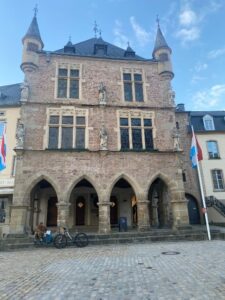
© Leon Maßem
It is definitely difficult to work at university, but I recommend everyone to experience it, as this is what most students will be working on in their future anyway.
Free time/tips
You work a 40-hour week and the work was more demanding than at university. I started in October and left in February, which meant that the sun was almost down when I got home, which made it difficult to do much outside activity during the week. I usually went out on Saturdays and Sundays, although apart from the city itself I found Luxembourg a lot quieter than Germany. However, Luxembourg has really beautiful nature and I would recommend at least visiting the very famous Müllerthal in the east with the Schiessentümpel waterfall if you like hiking. I would also recommend a visit to Vianden Castle in the north-east, which was not far from where I lived. The castle was renovated in 1977 when it was taken over by the state and is very beautiful. You can visit the castle from 10:00 to 17:00 and students only pay 5€. There is also a medieval festival which is very famous but unfortunately only in the summer so I cannot tell you about it.
The oldest city in Luxembourg is Echternach and it is indeed very romantic and has beautiful historic buildings. I also enjoyed the nearby Echternach Lake, where you can go swimming in the summer. There are many different walking routes around the lake and they have tried to place many activities around these routes such as skill runs or giant trampolines. The city of Trier (Germany) is only about 30 minutes east of Luxembourg and is worth a trip if you like Roman buildings. If you are visiting Luxembourg, you must visit the city as this is where the main activities and shopping centre are. It only took me 30 minutes from Wasserbillig, the city is worth a full day trip. The city is divided into the lower and the upper part a

© Leon Maßem
nd I would recommend to start with the lower part and work your way up (you have to walk a lot of stairs though). The upper part has a lot of shops, but as the cost of living is so high, the prices are absurdly high. Be sure to visit the Grand Ducal Palace, as Luxembourg is still a hereditary monarchy and this is the city residence of the Grand Ducal family. A little further out is the Kirchberg area, which is the city’s banking and financial district. Luxembourg City is one of the three seats of the European Union. You can visit the European Court of Justice, the European Court of Auditors and the European Investment Bank. It is in direct contrast to the older city centre, but I still enjoyed it.
I joined a local football club that works with Germans and we met weekly. I would recommend asking around in your area as this helped me to get in touch with the locals and I enjoyed every time we met. Many even smaller villages in Luxembourg offer free sports facilities, so make sure you find out about them. I also went to the Christmas market in the city. When you enter from the train station, you make your way to the Place d’Armes, where most of the market takes place. It is interesting that they have rides like a giant wheel but again everything is very expensive and crowded. I enjoyed it but to be honest I prefer the Christmas market in Aachen.
Conclusion
Looking back, I am incredibly grateful that I had the opportunity to do a research internship within a company in such a wonderful country during my studies. I am happy that I am growing as a person and that I have made wonderful memories in Luxembourg in so many beautiful places all over the country. Although the country is small compared to its neighbours, it offers a diverse cultural density and beautiful nature. I believe that going to another country all by myself and working independently on my own project has helped me develop and is useful for my future. A disadvantage was definitely the high cost of living in Luxembourg, which limited some activities I wanted to do. However, I would highly recommend Luxembourg to anyone and will definitely visit the country again.
Research Internship in Tarragona
- Chemistry M.Sc.
- Spain, Tarragona
- Institut Català d’Investigació Química
- 10/2023 – 02/2024
1. Application/Finding an internship
Before I applied for the research internship I did not have a clear idea which place to go. During the course of the chemistry master in Aachen it is necessary to do two to three research internships and I knew that I wanted to do one of them abroad. So, I asked the supervisor of my bachelor thesis whether he can recommend me some places to go. He directed me to a professor at the ICIQ in Tarragona which is a non-university research institute, perhaps comparable to the Max-Planck institutes and the likes in Germany. From looking at the group’s website I found the chemistry interesting and so I sent an e-mail with an application to the professor at ICIQ. He replied that he would be happy to host me, so we filled the required paperwork for the Erasmus internship.
2. Accommodation & Living expenses
When dealing with the bureaucracy of the stay, a secretary of ICIQ offered me a studio apartment of ca. 20 sqm total to rent. Despite its small size it was outfitted with everything one needs, like an oven, stove, refrigerator and washing machine. The biggest drawback was that I did not have a real bed but slept on a sofa bed instead. Looking back now I should have looked for a flat myself to first meet people outside of work and second because it was quite expensive (650 € per month), thereby consuming almost the entire Erasmus scholarship. There are cheaper options in Tarragona even though it was located in part alta, which is the historic centrum of the city. Travelling to Tarragona from Germany by ‘green’ means is relatively easy. There is a direct Flixbus connection from Cologne to Barcelona, taking about 18 h. This has the advantage that one piece of luggage is already included and more can be bought for 5 € a piece. From Barcelona it is only a short train ride to reach Tarragona. As far as I know there are no student dormitories like in Germany in Spain or they exist to a much smaller extent. Moreover, it is more common to continue living with one’s parents while studying so there is not something like a student quarter in the city.
Living in the historic center of the city has the advantage of being close to the historic landmarks of Tarragona, the cafes and restaurants as well as many cultural events such as the carnival celebrations. On the flipside the ICIQ is located on the outskirts of the city. Because of this, the walking distance to work was almost half an hour each way. Apart from the cost of the studio, I would say the living expenses are quite similar to Germany. Groceries are roughly the same price, but I really enjoyed the Spanish vegetables quality. I recommend to get a Spanish SIM card as the services are much cheaper than in Germany. There was no WiFi in my flat but I got 100 GB of prepaid mobile data for 20 € a month so I just used my phone’s hotspot for accessing the internet from other devices. If one has a Spanish bank account and is therefore eligible to get a plan it can be even cheaper.
However, I spent more money per month than I usually do because I went out much more. In my experience the culture in Spain is very different in that regard to Germany. I rarely met up with people at one’s home as you would do in Germany. Instead we went to the many, always well filled cafes and restaurants, for example to have some olives and vermouth in the afternoon. I spend a lot of time with my colleagues who were very welcoming and generally super nice people.
3. Everyday life/The internship
On a typical day I would wake up at around 8 am, have breakfast and then walk to the institute, so I would arrive around 9 am, if there were no meetings with the group or presentations scheduled earlier. We had one weekly group meeting in which several members of the group had to present their recent work which was then discussed among the group. Moreover, further regular group activities included literature, in which someone from the group presents a recent paper and subsequently leads the discussion in the group, topic, a more extensive version of literature where the basics of the specific niche are also explained and problem session. In this activity a member of the group prepares a total synthesis, removes some of the information like the products and/or conditions of the individual reactions and the group then has to figure out the synthesis and the mechanisms of the separate steps. I think most of these activities are pretty standard in academic groups in chemistry.
Apart from this we had subgroup meetings every three weeks to discuss our results and what needs to be done in the future more personally with the professor. The majority of my time in the institute I spent doing chemistry and trying to make the things work we talked about in subgroup meetings. In general, I had a lot of freedom after being put on one of the group’s project in the beginning in regard to which things I wanted to achieve and the methods used to get there within this project, which I really liked. I always felt like my opinion was valued and respected and there was a great sense of equality within the group. I never had the feeling that some of the PhD students or Post-Docs looked down on me or automatically valued my opinion less because I am a master student, which in my experience cannot be taken for granted.
The same applies to the use of the group’s and institute’s equipment. Everyone had the same rights in the access to it. Both the group and institute have great equipment. For example, the supply with glass-ware and technical equipment like GCs, LC-MS, GC-MS, glove-boxes etc. in the group is excellent. The institute shares more equipment like several NMR machines, which almost always made for very quick measurement times. Also, the institute hosts a whole analytics department, where one can submit among others HRMS and X-ray samples. In addition, there is a HPLC unit which can separate small quantities of sample for you. The digital equipment is very modern as well. There is a well-working chemical inventory for the single work groups and the institute as a whole. Everyone uses a digital lab journal to track their experiments, making it very easy to share results and procedures with colleagues. Though, because I am a master student, I was not provided with a PC at work and had to bring my own laptop every day.
Since there were many people in my group, I had to share my fume hood for the last one and a half months of my stay. Because the fume hoods are big this was not too much of an issue. The laboratories are quite large, in my group there were seven to ten people in one lab. Unfortunately, the ICIQ currently does not have canteen. There is one at the nearby campus of the university URV but it is not comparable to the mensa in Aachen. Prices are generally much higher (comparable to the prices for external people in mensa) and most days there are little to no vegetarian options. Because of this almost everyone brings their own food to work every day, so I had my lunch in the break room with my colleagues most days.
Most days I stayed in the laboratory until between 6 to 8 pm. On weekdays the institute is opened from 7 am to 10 pm and Saturdays from 7 am to 5 pm while it is closed on Sundays. I only worked on Saturdays on exception and I want to highlight that I worked these relatively long hours because of my own choosing as I really liked the chemistry I was doing and wanted to make progress. Nobody put on any pressure on me to work as much as I did and when I wanted a few vacation days it never posed any problem. Same as with the exact contents of my research I enjoyed a lot of freedom in my working hours. If one wants to have a more time off during an internship it is definitely possible.
In the beginning of my stay I had to undergo a lot of safety instructions like written tests, a presentation and a walk through the institute. I was provided by the institute with two lab coats and safety glasses. About one month into my stay I got into a laboratory accident were a splash of DCM entered my eye. Luckily, my lab colleagues were quick to aid me and washed my eye first with a special solution intended for these purposes and then water. They also alarmed the institution’s security department. A worker of this department then continued to wash my eye with salt water before taking me and a Spanish-speaking coworker to the hospital, where an ophthalmologist checked my eye for lasting damage. Luckily, there was no such damage and I was prescribed antibacterial eye drops. Nevertheless, my eye got infected because of the irritation caused by the DCM and I had to go to the hospital two more times during the next week. In the end it healed perfectly fine and I have no damage in my eye. The insurance of the institute handled everything with the hospital great so it was not stressful for me in that regard and I am very grateful to the lab mates and ICIQ employees who helped me.
The language of my stay was English as my group was very international, with only about 25 % of the group members being Spanish. Therefore, all communication within the group was in English. I do not know whether my language skills got better during the stay as I like to think that I was quite proficient before. Before the internship I also studied Spanish in university for a semester and longer in private. Unfortunately, I do not believe that it got much better during the stay. First of all, as discussed before I did not use it at work and second in my experience many people outside of work preferred to speak Catalan instead of Spanish (which are two different languages) as Tarragona is located in Catalonia. When they noticed I did not speak Catalan many switched to English right away. This meant I spoke very little Spanish during my stay.
Possibly because of the group’s internationality many group members do not know too many folks outside of work in the city, so we spend a lot of time outside of work together. Big cultural events like Christmas were also celebrated in the institute with the Catalan traditions or within the group. For example, we went to a fire place to do Calçotada with the group. In this tradition spring onions are burned in a fire. The outer layers are removed and the spring onion is eaten whole with a special sauce. I much appreciate that I got to experience these traditions.
4. Free time/Tips
A great way to spend part of the weekend is to support the local football club Gimnàstic de Tarragona (often abbreviated to Nàstic) in their fight for promotion to the second Spanish league. Usually about 5.000 to 10.000 people visit their games, creating a vibrant atmosphere, even though it cannot quite compete with Alemannia Aachen ;). Tarragona used to be an important roman city (named Tarraco), as it was their first permanent settlement on the Iberian Peninsula. Since the city’s population remained smaller than at its peak height in roman times until well into the 19th century a lot of the roman architecture is still standing today. The amphitheater located directly at the beach for example is part of the UNESCO world heritage. It is among six attractions from antique times and the middle ages which can be visited with a bundled pass for 15 €, an investment that is well worth its money. The surroundings of Tarragona also feature nice nature and hiking paths to explore it. For example, I once hiked to the roman aqueduct which is located 4 km outside of the city and its impressive to imagine that it has stood there for 2.000 years.
If you like climbing there is also a famous rock climbing area outside of the nearby city of Reus. Reus and Tarragona have kind of a rivalry going on as they are by far the biggest cities in the area. Reus can be reached by a regular bus service from Tarragona in about 30 minutes. I often went there as there unfortunately is no climbing gym in Tarragona but there is an excellent one in Reus I can recommend. Apart from this the city of Reus is surely worth a visit on its own. In the Christmas time there are nice markets where once can buy artisanal foods or typical Christmas accessories of the region like a Caga tió or the Caganers. Most smaller cities around Tarragona can also be reached by bus services. In addition, Barcelona is connected by rail to Tarragona. The ride takes 1 h 15 min to 1 h 45 min, depending on the train, allowing for many weekend trips. Supporting this is a current promotion of the Catalan railways in which one can buy an indefinite use ticket for four months for a specific route for only 20 €. If within this timespan one uses it at least 16 times, you even get the 20 € back! Tarragona possesses a separate high-speed train station on the route Barcelona-Madrid as well. This station is located 8 km outside the city, so it is connected to the city center by bus. From there, travelling to Madrid takes only two hours and connects to the whole Spanish high-speed rail grid.
Furthermore, Tarragona is located on the Mediterranean Sea and has some beautiful sand beaches alternating with small cliffs, so I often enjoyed taking evening walks along the coastline. Up until the middle of November the water was also still warm enough for me to enjoy swimming in the sea. Many people possess beach volleyball sets, so during the summer the beach is filled with beach volleyball courts. Obviously during the winter, the weather is much better than in Germany. The temperature rarely dropped below 10 °C and sometimes exceeded 20 °C in February, enabling outdoor activities year-round. Once a week I played football on a pitch belonging to a nearby school with a group of students and workers of the ICIQ and the nearby university URV.
Before I mentioned that I went out a lot for food and drinks. As a vegetarian I would say it is a little harder than in Germany when eating out. When going out for Tapas there are usually enough vegetarian options (at some places you might have to order every available one to get fed) but otherwise one can sometimes be somewhat restricted to only one to three dishes to choose from in total. In the worst case, almost every place offers Patatas Bravas, so one can reliably fall back on that. Vegan options however can be much direr, so you should check beforehand if there is something available for you. When cooking for myself though I found myself in paradise. The vegetable quality and variety available is amazing so vegetarian or vegan cooking is a blast.
5. Conclusion
Looking back, I had a great time in Tarragona. The people I met were super nice and welcoming. I hope that I have made some lasting friendships. Also, I experienced some Catalan culture, like carnival, the Christmas traditions or Calçotada. In and around Tarragona there are many cool options to spend one’s leisure time. Regarding the work I experienced a lot of freedoms and I found the chemistry I did super interesting. I also really liked the culture and atmosphere at ICIQ. Therefore, I can wholeheartedly recommend a stay in Tarragona and I will definitely come back either for vacation or to work.
Research Stay in Dublin
- Chemistry M.Sc.
- Ireland, Dublin
- University College Dublin
- 11/2023 – 01/2024
- Application/Finding an internship
My experience in this department might be less useful, as I received an offer from my professor in Ireland, rather than looking for an internship myself. However, I have understood from the other visiting students there that finding an internship was not the hard part about planning their stay in Ireland – generally, they have researched the groups with topics aligning with their interests and applied directly to the head professors of those groups. Afterwards, the process ran smoothly through the school manager, who explained how I should sign as a visiting Erasmus student on the UCD website and I received a student number and card, testifying my status as a visiting student. That also meant I got access to all the facilities and privileges a student would.
- Accomodation & Living expenses
Finding accomodation might be the most difficult aspect of planning an internship in Ireland. Dublin suffers from a veritable housing crisis, which makes finding a place, especially for a short stay of under one year, extremely difficult. Aside from that, prices are high, and average around 900 to 1000 Euros a month if you don’t want to share a room. Probably one of the best options is finding a host and living in their house – not only is this option cheaper, but it also allows for deeper, personal connections with your host and the possibility of getting tips from them on the best things to visit/experience in Ireland.
This was, in fact, the option that I chose. I met my host through a previous Airbnb visit in Dublin and contacted her again for this internship. Airbnb is a safe option to find accomodation for a short-term stay, and I highly encourage you to reach out to Airbnb hosts and ask them whether they can offer longer stays. It’s a great opportunity, since you do not have to pay any deposit this way, and much more secure than many other apartment-finding websites. In fact, a fellow visiting student got scammed with his first apartment, so contacting your professor to check the validity of your apartment offer is something you should do if you have the chance to.
This entire segment might seem rather disheartening, but I assure you that the hassle is worth it. Apart from the housing expenses, which the Erasmus scholarship mostly covers, the other living expenses are very much comparable to Germany. ALDI and LIDL are readily available, and even the restaurants in the city center are very much affordable. Once you clear the hurdle of finding a place, the rest is smooth sailing.
- Everyday life/The internship
One cannot forget that Dublin is capital, and, as such, is accordingly crowded. Taking the bus at peak hours can mean your commute might be as long as two hours – thankfully, the universities are also aware of this conundrum, for which reason the PhD students start at 10 o’clock to avoid the insane morning rush. That also means, however, that your work is done around 18 o’clock, by which time you get to experience the city lit up for the night.
In my experience, everyday life is comfortable – the bus connections are fairly good and frequent, and a 90min bus ride totals up to one euro if you order the youth card online (note that it must be ordered to an Irish address). There’s something quite rewarding about watching the city from the upper level of a double decker, like you’re about to conquer the day or you’re being rewarded for your hard work. Supermarkets are always close by and offer a wide variety of semi-cooked meals that you can easily bring into work for lunch. All in all, the daily needs are met with no problem – provided that, of course, you don’t forget to bring a power outlet adaptor, just as you would if you were to visit UK.
The university staff at UCD and the students I came in contact with were another highlight of my stay in Dublin. They’ve all been exceedingly nice and friendly, and any question, whether personal or science-related, was met with a helpful response. In one word, I would describe the people as warm – as soon as my first day, lunch discussions drifted towards restaurant recommendations and folk stories, so it’s fair to say that I have felt accepted into the group very fast.
In fact, my entire research felt like a collaboration. There was a constant exchange of ideas with the other students, and they were always ready and happy to help. I must, however, note that the scientific department was in the middle of reorganizing, so some of the facilities were harder or slower to access.
Another thing to notice is the clear difference between a PhD in Germany versus Ireland. In Ireland, the PhD is a four-year endeavor and no more – you are considered a student, and as such have a contract for only these four years. Regardless of the results you’ve obtained or how much progress you’ve made, your project time is up after four years, and there’s not much pressure to publish scientific papers. This, I’ve come to understand, is a double-edged sword: on the one hand, the atmosphere is much more relaxed and much less competitive than other academic experiences I’ve had. On the other hand, there’s not a general drive to improve, which may shackle you down if you do not have the support of your professor.
- Free time/Tips
Dublin is truly a charming city. Just taking a walk through the city center reveals centuries of history in its layered architecture, from the Middle Ages to the beloved pubs and more modern bubble tea shops. It’s fascinating to experience – as soon as you step into the city, everything is red bricks and old, authentic facades. It might be one of the most beautiful capitals I’ve seen so far, and one that offers much to do in your free time.
If you’re inclined to visit museums, there’s no shortage to choose from. From Dublina, which explains the relationship between Dublin and Vikings, to The Little Museum of Dublin, which takes you on a time travel back to the Irish war of independence and, most importantly, the Whiskey Museum – Ireland is so culturally diverse that you have no chance of getting bored. There’s a particularly strong drinking culture in Ireland, so apart from the Whiskey Museum, which serves as an entrance guide, there are more Whiskey Distilleries to visit than you can count. I ended up at Teeling, and absolutely loved the tour and the complementary whiskey plus cocktail.
If there is one word often associated with Dublin, however, that is beer – they are more than proud of the Guinness Brewery, and it is worth a visit just for its impressive size if panoramic view from the top restaurant, even if you aren’t much of a beer enjoyer. If you are, however, you’re in luck, because Dublin is bustling with dozens of pubs, where you can enjoy a pint of beer while listening to live music and eating an Irish roast.
Another must is enjoying a cup of tea and a scone – it doesn’t matter where, because you’ll find them everywhere. Just like mince pies, these are remnants of the 800-year long British occupation. If you go to the port, Howth, you’ll be able to not only enjoy the amazing hikes, but also fresh fish and chips. Despite this strong British influence, Ireland is the very definition of a multicultural city – people from so many walks of life have settled here that you can find virtually any cuisine you’re craving, be it Japanese, Mexican, Greek, Korean or Italian.
Ireland is also known for its nature – if you rent a bike, it’s worth taking it outside of the city to see the beautiful landscape. If you don’t, however, you can still rent one in Phoenix Park, another must-visit on your list, if only to see the deer. You might have to search a little for them, and the park is extremely big, but definitely worth a visit.
- Conclusions
All in all, I would rate my experience at UCD, and in Dublin, in general, as positive. UCD was well-equipped from a scientific point of view, and depending on the research field that you want to deepen your understanding of, it might make a great experience to add to your resume. The people were very helpful, even though the general level of research-motivation was below what I was expecting.
The city itself was wonderful. I was lucky enough to be there around Christmas and enjoyed Dublin in all of its festive glory. The atmosphere pulls you right in, and it makes it easy to forget that you’re far away from home. The people were very warm and friendly, and I was lucky enough to have a pair of wonderful hosts that I would engage in many a conversation with. The openness to foreign visitors and the ease with which I was accommodate made it so that Dublin is now one of my favorite places in Europe, and I can’t wait to return as a tourist.
Wonderful Erasmus stay in Madrid
- Chemistry M.Sc.
- Spain, Madrid
- Centro de Astrobiología (CSIC/INTA)
- 09/2023 – 12/2023
Application/Finding an internship
I wanted to go for astrochemistry. That’s the one thing I had in mind when going through all sorts of research institutes in Europe which promised somewhat better weather than Germany. Then, a warm autumn night in Spain must be the perfect addition for stargazing. Eventually, I wrote an email to the Center for Astrobiology (CAB) in Madrid, where I reached out to the Head of the Interstellar and Circumstellar Medium Group. He happily accepted my application and offered me to stay for a research internship in his group. The CAB is a subdivision of the Instituto Nacional de Técnica Aeroespacial INTA, a state institution. There, lots of paperwork and filings were required, but eventually, my stay was official and my badge was ready. Now let’s go, from Aachen to Madrid.
Accommodation & Living Expenses
The campus of INTA and CAB, positioned in the far outer circles of Madrid, and more close to the smaller towns of Alcala de Henares and Torrejón de Ardoz, made me take a 45-minute bus ride from Madrid every morning. I could have chosen to live in the smaller towns. but would I want to miss, living in the centre of one of the biggest metropoles of Europe? Definitely not! I got myself a flat via the local agency viveyestudia.com, which focuses on accommodations for international students. I had a good correspondence with their agent and got a good comparable price(485€ per month). I went to live with 3 other students from all over the world and immediately made good friends with them.
Madrid itself is huge. I may repeat this, Madrid is huge. Even if the Madrid Metro system is one of the best I personally know, it is still good to live in a well-accessible area. My flat was close to Plaza de Manuel Becerra, a crossing of two highly important Metro lines (2 and 6) and a lively but not hectic area. Perfect to reach everything and still not drowning in the noise of the city. Additionally, the metro is wonderfully cheap and extremely powerful to get everywhere, even far outside of the city with no further expenses (Toledo, El Escorial or the Sierra de Guadarrama) Get yourself a Personal card (TTP) as early as possible and pay 8€ or 20€ per 30 days to get pretty much everything!
To taste some of the best local Spanish culinaries I often went out to pay the extra money but never felt overwhelmed by any prices for food or drinks. Especially for buying groceries and cooking in our own kitchen seemed wonderfully inexpensive (at least in comparison to Germany)
The general culture in Madrid is perhaps the best aspect regarding money and expenses, as most museums, palaces, or other cultural sites are either free or highly subsidized.
Everyday life/ the internship
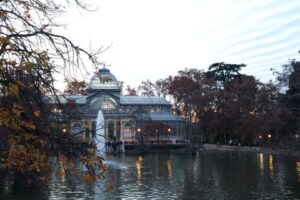
The Glass Palace
© Timon Francis Kielgas
Every morning, during weekdays, there was exactly one bus to get me to CAB. 7:15 in the morning gloom, was when I hoped on to snooze for another bit until I started my day in my Lab at 8. My days either consist of planning or analyzing data from experiments or emptying cups of coffee while letting a simple question about space evolve into a one-hour discussion remotely tangential to my research. Then, perhaps my biggest personal cultural shock, we had lunchtime at 2 p.m., way too late in my opinion, but that’s the Spanish way I was told.
On days when I was absent from the CAB, the weekend and luckily lots of Spanish holidays late in the year, I was adamant, that it is impossible to see everything in Madrid in just three months. After three months this still held true. I spend days on end wandering through Retiro Park, the Prado Museum or the endless bars and tapas places of Malasaña, always finding something new.
Free time/tips
One of the most important things, and as said before, get a Personal card (TTP) for the Metro, as early as possible, because it is that damn good to get around with. To get a great first impression of Madrid I highly recommend the Faro de Moncloa, a tower with a breathtaking observation deck, from which all the important sites of Madrid and its surroundings are visible. Another thing is the Gran Via, which itself is no secret tip because it is THE tourist hotspot. But you have to look up the dates of some special occasion when the Gran Via is closed down for cars to have pedestrians walk all over the place. It’s a wonderful way to observe the vibrant road in a completely different way.
While walking the streets of the Spanish capital, at no point you will go sparse on Spanish European culture. Especially then you have to keep in mind that Madrid is also strongly connected to all the other countries in the Spanish-speaking world of Latin America. If, like me, who has not been to South America before, Madrid is a wonderful place to dive into these cultures as well. Order some Pisco Sour in a Peruvian bar, get a plate of the best Columbian dishes to fill you up or try all the empanadas you can find.
Conclusion
Madrid is a beautiful city, with beautiful weather and wonderful research and researchers. Perhaps my most ambiguous but most remarkable impression was, that everyone I met was super friendly and a joy to be with. While the culture is bright and interesting and the city life is vibrant and beautiful, it was the people I got to work and live with, who made this whole stay the best. I can not tell if it is the field of Astrosciences, if it is the attitude or the people there in Spain, or if it is just pure coincidence, but doing research in this group at CAB just felt good!
I hope others will come to Madrid, have a wonderful Erasmus stay, and share my experience.
Internship in Romania
- Chemistry M.Sc.
- Romania, Bucharest
- National University of Science and Technology Politehnica Bucharest
- 09/2023 – 11/2023
Application & Search for an internship
Romania is home of many inventors and known for its research in many scientifical fields. I am studying chemistry, so naturally I wanted to get to know and experience
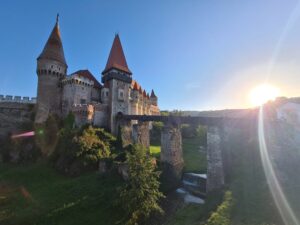
Corvin’s Castle
© Andreea Maria Rânea
the scientifical research in the capital, Bucharest. Since I went for a two-month research internship, the process of applying was different and simpler than going for lectures. I searched for scientific topics of interest and started first looking at University Politehnica of Bucharest, as it has a good reputation. This is how I came across the National Center of Micro and Nanomaterials. My application was done three months in advance, directly to the director of the center, who happily accepted me. As for the bureaucracy, I only had one formular to fill out for my internship to be recognized at RWTH. Romania is part of the European Union, so no visa is required, and if you have a German health insurance, your stay is covered under the European Health Card.
Accommodation & Living Expenses
The University offers all students a place in the dorms, which are near the main campus. In the rectorate, located in the main campus, there is a cafeteria on the top floor (on the terrace) with a look over the campus and with fresh traditional Romanian food. The price of a full meal was around 3 Euros, and you could also have traditional soup for 1.4 Euros. Alternatively, the biggest mall, Afi Palace Cotroceni, is situated 10 minutes on foot from campus, so the possibility of eating at different restaurants can also be taken into consideration.
The University is easily accessible- you can take either the metro, buses, or tram to the University gate. There is a common card which you can use for all these transportation means and the metro fare for example was 1 euro/ 2 trips.
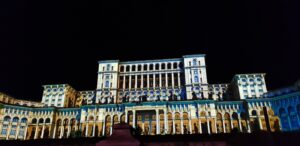
Palace of the Parliament (under light show)
© Andreea Maria Rânea
Groceries are also relatively cheap, so if you wish to cook for yourself, you can find high quality bio vegetables and meat which you can buy directly from the producer. There are many weekly markets with producers from all over the country too.
Everyday life/ Internship
Romanians are generally very welcoming people and usually make it their mission to include new people and make them feel at home. I could feel that especially in my laboratory, where every member would constantly come to me, ask me my progress, if I have any difficulties, if I want to grab lunch together, the list goes on. Even some of them with different expertise and research than mine would sit down with me and brainstorm reasons to explain my results when I needed help. Furthermore, as we sat down one day with the director and another professor, we got to hear stories about their youth and university time, which was quite different from university today. I was surprised to also hear stories about Romanian chemistry figures like Costin Nenițescu and get so familiar with those times. I think it was very nice to befriend the professors and other members like that, instead of only keeping a distanced professional relationship. Going to the laboratory daily felt warm and welcoming.
After I got my safety and general introductions of the laboratory, I could start to work right away. My research was on the synthesis and doping of hydroxyapatite for medical applications. For this synthesis I first used a microwave assisted reactor for hydrothermal method. I also got to personally use the X-Ray Diffraction spectrometer and assist experts for the Scanning and Transmission Electron Spectroscopy. The laboratory was equipped with new generation devices for the best analysis results, as well as all necessary materials for my research. I also got to work again with cells for viability and cytotoxicity tests since my bachelor’s thesis. The bio-safety laboratory was placed in a new building, also on the main campus. From
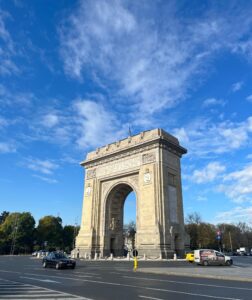
The Triumphal Arch Bucharest
© Andreea Maria Rânea
September to November there was very good weather in Bucharest, with temperatures even exceeding 30 degrees Celsius at times, so the walk through the campus between the buildings was a nice change of scenery during work. With the start of the semester in October it got livelier, also since most students spend their breaks outside (the line in the cafeteria got longer too unfortunately). Another endearing fact was that the group had three aquariums with fish and turtles in the common room, which personally lifted my spirit every day, as the turtles would always come forth to greet you.
During my time there, I was invited to join the Conference of the Romanian Electron Microscopy Society which was held in Cluj-Napoca. This conference was attended by many Romanian and foreign electron microscopy specialists, as well as well-known electron microscope producers like Zeiss, Jeol and Thermo Fisher Scientific. It was a great experience for me, as it was the first scientifical conference of this type that I attended, and it gave me meaningful insights for my future career. Furthermore, I had the opportunity to attend three PhD thesis defenses, also a first for me. The tradition there was that after the presentation, the new doctor would organize a catering for the group to celebrate. There were also a lot of emotions involved and praises coming from the jury, which was formed interdisciplinary, with professors from chemical and medical faculties.
Free Time & Tips
Outside the laboratory I would generally meet friends and walk through the city. We would go down the Victoriei Boulevard and grab some ice cream at one of the best shops I visited (Gelateria La Romana) and then enjoy the George Enescu classical music festival in front of the Royal Palace. Another beautiful sight was the Palace of the Parliament, which is the second largest administrative building after the Pentagon, as well as the heaviest building in the world. The materials used for its construction are almost entirely of Romanian origin, with thousands of tons of crystal and millions m3 of marble, wood, and woolen carpets, as well as velvet and brocade curtains with silver and gold embroideries.

Unirii Square Fountains
© Andreea Maria Rânea
The streets were always full until late, as the shops and restaurants close at 10 PM or later. On Sunday all facilities are open as usual, and you can always find a non-stop shop or even pharmacy. The Old City (Centrul Vechi/ Lipscani) is a glimpse of the old streets of Bucharest, which kept the old buildings and churches as well and is well known as an entertainment center, being home to various restaurants, bars, and clubs. A restaurant that you must visit while in Bucharest is “Caru’ cu Bere”, traditionally decorated and which offers traditional live music as well as traditional dance performances every day. If you are unsure what to order, some typical traditional dishes are “Mici/ Mititei”, “Sarmale”, “Ciorbă de burtă”, “Mămăligă (Polenta) with sour cream and cheese” and “Ardei umpluți”. I also recommend you make a reservation beforehand, if possible, as it is usually very busy. Besides the varied nightlife there are a lot of activities that you can do. Theater is also famous in the Romanian culture, and there are many theaters in Bucharest. I also got to see in premiere the piece “The Envelope” written by famous Romanian novelist Liviu Rebreanu. After the laboratory I would also go to the Dinamo Stadium for track and field training.
On the weekend I traveled to the mountains, to cities like Brașov and Bran, which is known for Dracula’s castle, the Bran castle. Dracula as known today was ins
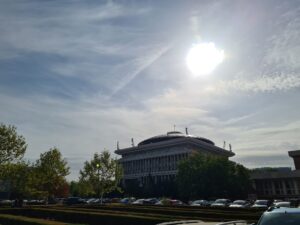
University Politehnica of Bucharest
© Andreea Maria Rânea
pired by Vlad III Voivode of Wallachia, also known as Vlad the Impaler or Vlad Drăculea (Dracula), his first nickname being related to his execution method and the second being his name in the Order of the Dragon. Finally, there were a lot of historical buildings and sites with a lot of stories to tell throughout Romania.
It is important to note that Romania has one of the biggest brown bear populations in Europe, and if you travel to the mountains, you might come across them. If you plan to go on a hike, you must pay attention to the signs and follow the set paths. Also, if you choose a hotel situated in or near the forest, you will get warned by the staff not to walk outside during the night, as you might just encounter one. Sometimes you get to see them from your window too, or on the side of the serpentines, just minding their own business.
In Poiana Brașov you can find two of the best traditional Romanian restaurants, which I totally recommend if you ever visit there.
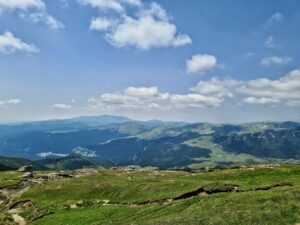
Bucegi Mountains
© Andreea Maria Rânea
These are „Stâna Turistică Serghiana” and „Coliba Haiducilor”. Each has a different charm, and both have traditional live music and decorations. For the first one I recommend to eat outside, at the highest level for the best view, and for the second one inside, for the best atmosphere.
As I said before, Romanians are very welcoming, and you can notice this anywhere you go. Even if you don’t speak the language, the majority of Romanians can speak fluent English and usually other languages as well, like German, Italian, French and Spanish, Romanian also being a latin language.
Conclusion
In conclusion, my research at University Politehnica of Bucharest was a valuable experience for me personally as well as academically and offered me important insights to consider for my future career. Also, there are a lot of stories I could tell about my time there, as my experiences were very varied. The atmosphere is generally very warm and relaxed, and if you plan your research well, you won’t feel too pressured or overwhelmed. I am grateful for being supported during my internship by the Erasmus+ grant and to represent RWTH Aachen University and I definitely recommend a stay abroad in Bucharest as I had a wonderful time there.
Research Internship in Santa Barbara
- Chemistry M.Sc.
- United States of America, Santa Barbara
- University of California, Santa Barbara (UCSB)
- 05/2023 – 09/2023
- Application/Finding an internship
Studying Chemistry M.Sc. at RWTH Aachen University comes with three mandatory research internships which optionally can be completed at an external institution. Inspired by a talk at a conference I contacted the professor via e-mail asking for a research stay about nine months in advance. After her approval the administrative process including some visa guidance was handled by the Department of Chemical Engineering and the Office of International Students and Scholars (OISS) at the University of California, Santa Barbara (UCSB).
Applying early, I got the visa about four months in advance. The OISS at UCSB is an approved J1-sponsor. Several documents were required by the Department of Chemical Engineering and/or the OISS. I needed proof of health insurance, financial proof and a language certificate among others. The DS-2019 was issued by OISS at UCSB and is required for the visa application. Additionally, a SEVIS fee is required prior to the visa interview. In my case, the interview waiver applied which allowed me to send in my passport to the
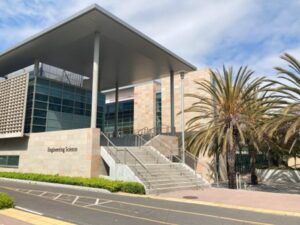
Engineering Science Building
© Elisabeth Richter
consulate in Frankfurt and have it sent back to me once the visa was approved.
Applying early, I had plenty of time between the approved visa and my starting date so I could book my flight and look for an accommodation several weeks in advance. Since I was a visiting grad student not taking any classes I was not enrolled as a UCSB student and did not have to pay any tuition fees but also did not get the student benefits.
- Accommodation & Living expenses

Recreation Center
© Elisabeth Richter
Housing options are either student housing on and off campus or private housing in Isla Vista, Goleta area or Downtown Santa Barbara. The latter requires a daily commute by bus or car to the campus whereas the other options are within walking or biking distance.
As a visiting grad scholar, I was not eligible for student housing. I found a nice host parents arrangement living with up to two other students via a private housing listing provided by UCSB. Leasing or Subleasing is usually tied to the quarter system. In general, be aware of scams. Compared to Aachen, living expenses are higher in America and particularly high in the Santa Barbara area. For a single room about $1300 per month are common whereas doubles or triples are usually a little cheaper. Compared to Aachen, my expenses for groceries went up 1.5 to 2 times. Even though going out is much more common I had a lot of self-cooked meals. In general, fruits and vegetables are more expensive. For fresh, organic fruits and vegetables I recommend the farmers market which serves the best sourdough bread I had during my stay.
- Everyday life/the internship

Campus Point Beach
© Elisabeth Richter
Biking is the way to go around on the UCSB campus. The best chances to not get one’s bike stolen is in having a cheap bike and a U-lock. Used bikes can be purchased in a bike shop in Isla Vista or online. Outside of campus busses as public transportation are an option but depending on where to go cars might be the only choice.
Major food options on campus are in the UCen building serving sandwiches, burgers, and American Chinese food among others. In addition, there are cafes distributed throughout the campus selling mostly sandwiches and snacks.
The research group I visited provided lab space as well as a desk in the offices. Working with several colleges on a project I was fully integrated in the group during my stay. On average, I had biweekly meetings with my professor at UCSB discussing my research progress and giving valuable input. I attended the weekly group meeting taking turns in presenting one’s research progress and recent literature.
I usually worked in the lab on weekdays and used the evenings and weekends to explore the area. The recreation center offers intermural, fitness and dancing classes among others. The campus is right next to the ocean and always worth a visit. Part of the campus is the Campus Point which beach area is suitable for beginners in surfing.
One thing to keep in mind is that I stayed at UCSB during the summer which is way quieter than throughout the rest of the year. Same goes for the research group because of the lack of lectures but professors might not be available each week due to travelling to conferences or summer schools.
- Free time/tips
The campus itself is beautiful and a walk around the campus lagoon is a must. You can get a great view of the campus from the upper floor of the Davidson’s library both towards the mountains and the ocean. I highly recommend spending time at the ocean and watching a lot of sunsets. The surf class by the USCB recreation center is a lot of fun. They provide surfboards and wetsuits during the lessons and there is also a rental option at Campus Point Beach.
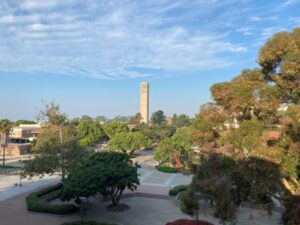
Campus and Storke Tower
© Elisabeth Richter
Going out there are some bars and breweries in the Goleta area to check out (beers can be purchased starting from about $7; remember the legal drinking age of 21) and even more options in Downtown Santa Barbara. The bus ride to Downtown takes 35 to 55 minutes. Alternatively, there is a 10-mile bike path connecting UCSB and Downtown Santa Barbara. Main attractions are the Santa Barbara Mission, the botanical garden, a walk on State Street and the waterfront. Ferries are connecting Santa Barbara to the Channel Islands National Park which is a great destination for hiking and camping. Whale Watching tours starting in Santa Barbara might go all the way to the Channel Islands seeing dolphins and humpback whales along the trip.
Both Goleta and Santa Barbara are connected to the Pacific Surfliner which goes from San Luis Obispo all the way south to San Diego. The train track itself is right next to the ocean giving this slow way of traveling an amazing view throughout the ride.
- Conclusion
My research stay at UCSB was a fascinating journey. I broadened my knowledge in Chemistry and gained a lot of new experiences on the personal level as well. Even though it took me some time to get used to the different culture I enjoyed the way of life. Within time, communicating in everyday English became natural and I understand and highly acknowledge the American humor by now. I met great people along the way to which I will catch up eventually. I highly encourage a stay abroad.
Research Internship in Dublin
- Chemistry M.Sc
- Ireland, Dublin
- Trinity College Dublin (TCD), Trinity Biomedical Sciences Institute (TBSI)
- 04/2023 – 09/2023
Application and Preparation
I have thought about completing part of my studies abroad during my master’s degree in chemistry ever since the first semesters of my bachelor’s degree, and because Ireland has always been a very fascinating country to me that I have planned on visiting anyway, I chose Dublin as the place where I wanted to do a research internship. Additionally to the beautiful landscape and the friendly people I envisioned to encounter, Ireland has the advantage of being an English-speaking country with many excellent universities to choose from. During the master’s in chemistry at RWTH Aachen University, students are required to do several research internships in different groups and fields of chemistry, but we are free to select the location and the group, so I decided to do an internship in Ireland instead of a semester abroad where I have to take courses. Therefore, I began applying to different groups about six months before I wanted to start the internship, which is quite late in hindsight, and I would definitely recommend starting earlier. Unfortunately I had the experience that most professors did not answer when I directly applied with a CV and a letter of motivation via e‑mail, which is why I asked a professor from Aachen to help me out in this regard, and that ended up bei

The Trinity Biomedical Science Institute – my workplace.
© Hannah Höche
ng the solution to my problems. After finding a group where I could complete my research internship and agreeing on the duration of the internship and the topic I would be working on, I started applying for Erasmus funding and filling out all necessary documents like the Traineeship Certificate. In addition, I applied for a leave of absence during that semester, which has to be done during the registration period for the following semester.
Accommodation and Living Situation in Dublin
Before I start explaining how I found an apartment in Dublin, I want to mention that this city is very, very expensive compared to Aachen and it is a real struggle to find an accommodation, which I was aware of before moving to Dublin, but the rent and the general cost of living is even higher than I would have expected. I would recommend starting to look for an accommodation as soon as possible, since a lot of apartments and rooms are listed for up to a year in advance, so even though I was searching for apartments where I could move in in April 2023, I saw a lot of offers for the following year. I used the popular websites daft.ie and let.ie, where you can also filter options like the number of rooms, the price or the duration of the rent. A lot of apartments and rooms can unfortunately only be rented for at least one year. I also looked up the location of the building I would be working in so I could find an accommodation reasonably near to be able to walk everywhere. In contrast to Germany, where you can use your semester ticket for public transportation, in Ireland you have to pay for every trip, but more on that later.
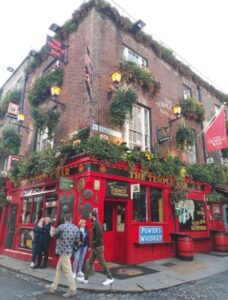
The Temple Bar.
© Hannah Höche
When finding a suitable apartment, I wrote to the landlord, but the reality is that they rarely answer, especially when the apartments have been uploaded to the websites for a few days. Therefore, I adapted my strategy and I searched for several times during a day to be able to immediately message the landlord when an apartment was uploaded – and I messaged a lot of people. It also helps to have a pre-written text where you only change the address. Sometimes they also offer online tours of the apartment, which is helpful when looking for apartments when still in Germany, but generally I had the experience that tours are in person. I also strongly advise to not just get an accommodation and transferring the money without having seen it and signing a contract, because there are rental scams in Dublin and even the websites of the different universities warn students to be careful. To be able to actually look for apartments and rooms, I would suggest to come to Ireland about one to two weeks before starting the internship or semester and then to actively go to apartment tours. I also prepared all the necessary documents so I could immediately express my interest in the accommodation. Generally, Dublin is divided into two areas by the river Liffey, and the south side is considered to be the “better” and safer area of Dublin. There are student accommodations, but they are also very expensive and generally hard to get, and my professor actually advised against trying to apply for the housing
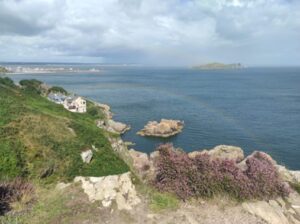
Howth, a peninsular village and outer suburb of Dublin.
© Hannah Höche
program and instead look for apartments.
In addition to the high rent, groceries and other necessities are more expensive than in Germany, so definitely try to save up beforehand. The public transportation also has to be considered, but you can save some money by getting the so-called TFI Leap Card, or the Leap Card for young adults in particular (aged 19 to 23). Although you can get pretty much everywhere by bus or the Luas, especially busses tend to be late and unreliable (at least outside of the city center). In this context, it has to be mentioned that tickets for the busses have to be bought from the bus driver when not using the Leap Card, and only coins are accepted.
Furthermore, I suggest checking with your insurance company whether you are insured for a stay abroad. Regarding phone calls, I just used my existing contract, there was no need to get a new one. Getting Wi-Fi for the apartment was a bit more tricky, because most internet contracts are only for at least a year, so I had to get a “pay as you go contract”, where you pay a certain amount every four weeks before you can use the internet, and I also had to buy a mobile router for that. You generally do not need to carry cash in Ireland (except for the bus as mentioned above), debit cards are widely accepted – if not everywhere. A lot of people also use Revolut (or sometimes PayPal). What I highly recommend is getting a credit card, because a lot of the tours I booked or sights I wanted to see could only be paid using a credit card. The bus companies that are driving to the airport (like Dublin Express or Aircoach) also only accept a credit card.
The Internship
I can honestly say that my research internship was one of the best experiences I had so far in a group. My professor Mathias Senge was a wonderful mentor and supervisor, who gave me my own project to work on and I learned a lot of skills that are useful and transferrable to any lab I will be working in in the future. My work day usually began at 9 am and ended at 5 or 6 pm and consisted of synthesizing my target compounds and purifying them, as well as literature research and the usual lab work. We also had regular meetings where we either presented our own research or papers from the literature we found interesting and helpful. I even got the opportunity to visit a conference and present some of my work in the form of a scientific poster. My colleagues in the lab were all incredibly nice and welcoming and helped me with any questions and problems. As for the requirements of the internship, I had to give an introductory talk and a final presentation for both my professor in Dublin and the professor supervising my internship from RWTH Aachen University, and I had to turn in a research report. In addition, I had to write monthly progress reports, but that was expected from my professor in Dublin and may not be a general requirement.
Free Time and Tips for Ireland
A lot of the Irish people I met told me that I have not really experienced Ireland if I only visit Dublin, and I can absolutely confirm that, Nevertheless, I want to start with some of the sights of the capital that I really enjoyed. Some of the museums in Dublin (The Dead Zoo, The National Gallery, The Archaeological Museum) are free of charge and definitely worth a visit. There are also several beautiful parks (Phoenix Park, St. Stephen’s Green, …) to enjoy, as well as distilleries that offer tours and tastings. Of course the popular tourist attractions like the Dublin Castle, Christ Church Cathedral or the
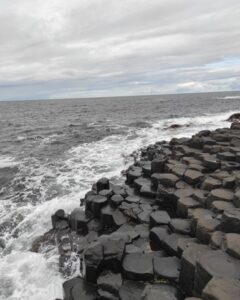
The Giant’s Causeway.
© Hannah Höche
Guinness Storehouse are also to mention, but they do cost money. A stroll through Temple Bar and along the river Liffey is also nice and free of cost. One of my favorite things was a visit to the Kilmainham Gaol, where I learned a lot about the history of Ireland – but tickets are very limited, so plan a visit 28 days beforehand to be able to get one (although there are sometimes returned tickets you might be able to get spontaneously). Lastly, a visit to any pub is pretty much a requirement and a lot of them have live music on the weekends, which makes a trip even more enjoyable.
Ireland has to offer such a wide variety of landscapes and nature spots, it is difficult to pick only a few. Not far from Dublin and reachable by the DART are Howth and Bray, where you can enjoy Cliff Walks and hiking trails. In order to comfortably travel, I recommend either the Irish Rail, bus services or booking trips from the popular tour operators, whereby the latter are quite expensive. Travelling by train is fairly straightforward and discounted tickets for students (a Young Adult Leap Card is necessary) are offered. The tickets can be bought online, but they have to be printed at the ticket machines at the train station (e.g. Heuston Station). Cities like Cork, Waterford and Killarney are easily reached via the train. Also, as a tip when visiting Cork, a little trip to Cobh, a seaport town and the last departure point of the Titanic, is absolutely recommended.

Cobh, a seaport town on the south coast of County Cork.
© Hannah Höche
In general, trips to Galway and the Cliffs of Moher, Kilkenny, Glendalough or even to Belfast and the Giant’s Causeway in Northern Ireland are an absolute highlight. The latter has to be one of the most beautiful spots I have seen, even though it is hard to pick a favorite. Even though a lot can be travelled by train or bus, some hiking trails or even cities and counties are unfortunately best reached by car.
Conclusion
I am incredibly grateful to have had the opportunity to spend a whole semester abroad completing a research internship. Not only could I acquire skills and knowledge in the laboratory and grow as a person and chemist, I got to make wonderful friends and see and visit the most beautiful spots I could imagine. My research internship taught me to work independently on my own project, which is very helpful as a preparation for both my master’s thesis and my aspiration to do a PhD. The only negative aspect about my stay abroad is the cost of living in Dublin, which would probably not have been possible for me to pay if I would not have had savings. Otherwise, I think it is an incredible experience to spend some time in another country and get to know the culture, and I would of course recommend Ireland as I really enjoyed my time there.


